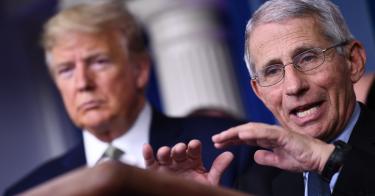America is enduring a public health crisis of a magnitude not seen in decades, perhaps since the 1918 flu epidemic, but that doesn’t change the fact the United States is a “can-do” nation.
Our history is clear: When faced with crisis, we respond with grit, determination, and innovation–regardless of the severity of the problem.
The coronavirus challenge is no different. It not only affects the health of Americans, but also our economic security and well-being. We must grasp the medical challenge and take aggressive action, including social distancing, massive testing, and the rapid delivery of therapeutics.
As we manage the public health crisis as best we can, it is equally important to plan for the aftermath, when we “bend the curve” in reducing infection and contagion.
President Donald Trump got it exactly right in his March 22 tweet: “We cannot let the cure be worse than the problem itself.”
From a medical perspective, the path forward is relatively easy to understand: Test, isolate the infected, and bend the caseload curve downward.
We could, of course, cavalierly dismiss the public health danger–“damn the torpedoes, full speed ahead”–but that would be catastrophic for certain vulnerable segments of our population.
We would end up in a continued exponential growth of infection that could overwhelm our hospitals and medical professionals and further worsen our economic condition.
Instead, as the president has indicated, America needs a nuanced, balanced approach. As we reach the peak of infection, we should focus on adjusting our approach to protecting the public health. This will require continuing to ask patience of our fellow citizens who are most vulnerable and at highest risk by prolonging their isolation.
For others, we can protect their health by continuing to ramp up production of the tools we need to manage, treat, and prevent this highly contagious disease.
The president has addressed the problem of equipment shortages, such as ventilators and respirators. He has cleared away regulatory barriers to the emergence of these tools by making it easier to produce them and companies are beginning to respond.
And prevention will require us to observe the new standards of personal sanitation that America’s outstanding public health experts such as Dr. Anthony Fauci, director of the National Institute of Allergy and Infectious Diseases, repeatedly have urged us to continue.
Despite the enormous disruption caused by COVID-19, the disease brought on by the new coronavirus, some remarkable things have happened.
Tremendous fear and anxiety arose in the first days of this pandemic, but most of us were quick to realize that we are all in this together, not only as a country but also as members of the world community. In a fast-moving, ever-changing situation, public health officials swiftly began to record accurate data and share it on an almost real-time basis.
Officials applied previous successful management techniques. Bright minds began to consider how existing medications could be brought to bear without the need for prolonged double blind studies that new medications would require.
As normal manufacturing ground to a halt, America’s industries reassigned their means of production to address shortages of ventilators, masks, and pharmaceuticals now and for the future.
And finally, most politicians at the state and local levels put their political differences aside and cooperated with each other, with our president, with the Centers for Disease Control and Prevention, and the National Institutes of Health.
Public health officials at every level have been working together to coordinate our response to COVID-19’s threat to individuals and to our health care system.
The response goes far beyond the heath system. Almost overnight, education moved from the schoolhouses and universities to the internet. To meet the demand for bandwidth, internet providers responded with increased speed for their customers.
Neighbors did what they always do, reaching out to infected or otherwise homebound friends and relatives to bring food and other necessities. All of us quickly understood that sacrifice was necessary.
Now we need to direct that same energy and cooperation toward reversing the damage done to our economy by the pandemic. We shut our society down quickly, but in an orderly way. We must turn our attention to the treatments and steps that will help us power it back up in a similar fashion.
And once we are past this current moment, we also need to figure out–in a calm and deliberate manner–what worked and what didn’t work in this difficult period.
Just as we need to review the strengths and weaknesses of our health care regulatory system, we need to review our public health response: what we did right, what we did wrong, and how we can improve.
As a nation, as a leader in the world community, we need to leverage our ability to collaborate by discussing how to do it all better next time, in a constructive way, without recriminations.
There will be a next time.
This piece originally appeared in The Daily Signal




